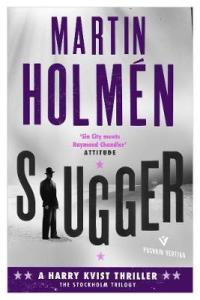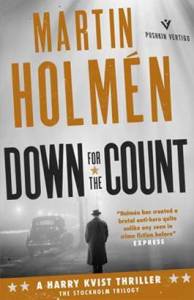Slugger – Martin Holmén
 ‘Slugger’, the final novel in Martin Holmén’s Stockholm trilogy, set in the 1930s and featuring former boxer turned debt-collector Harry Kvist, fully lives up to the high expectations set by the first two, ‘Clinch’ and ‘Down for the Count’.
‘Slugger’, the final novel in Martin Holmén’s Stockholm trilogy, set in the 1930s and featuring former boxer turned debt-collector Harry Kvist, fully lives up to the high expectations set by the first two, ‘Clinch’ and ‘Down for the Count’.
Kvist prides himself in never having gone down for a count in a brief boxing career in which he defeated all opponents but ended up shamed and marginalised, to put it mildly, for being exposed as a homosexual, and in ‘Slugger’, Holmén does justice to his hero, further upping his game and producing a fitting finale to the trilogy. ‘Slugger’ is a gritty noir that pulls no punches to the very end, a remarkable novel translated into English by A. A. Prime in which Holmén transports his readers to the dark underbelly of 1936 Stockholm, writing with raw energy and no-holds-barred bluntness.
Holmén works the reader as a boxer pummelling an opponent with body blows, and his rendering of place and atmosphere is a hit to the solar plexus: it’s working class and underclass Stockholm, it’s street and gang crime, it’s people with precious few possessions and even less hope. It’s a time and place far from the experience of contemporary readers and yet a disturbingly familiar one in some respects. Because of the stark contrasts between the haves and have nots, a feature of every society, even our own, which Holmén describes with chilling detail.
Holmén takes his time with the story as he weaves the sights, sounds and smells of working-class Stockholm into the narrative, slowing the pace down occasionally but making the fabric of the novel all the more intense. The very image of Kvist, a former sailor and rogue boxer with a weakness for schnapps and good-looking members of his own sex, now living on the fringes as a very persuasive debt-collector.
Nearer forty than thirty, Kvist is feeling the strain of a rough life during which he spent several stints in prison, but still there is an essential dignity to him, something of a conscience alongside his yearning for his wife and daughter, who both left many years ago to try their luck in America. Kvist makes do, like all his neighbours in the underprivileged district of Sibirien, and looks after his paralyzed, dying friend Lundin, an undertaker. Kvist’s only distractions are booze and the occasional homosexual liaison, his only hope is to somehow manage to make something of himself, despite the odds stacked against him, and to rustle up enough money to leave a city he no longer feels he belongs to, bound for the USA.
Stockholm is suffocating in an unprecedented heatwave when Kvist discovers that his only other close friend besides Lundin, Pastor Gabrielsson, has been savagely murdered, nailed to the floor of his church with rail spikes, a star of David painted with his blood next to his naked body. The police are inclined to believe Gabrielsson was murdered by Jews but Kvist knew Gabrielsson was a convinced anti-Nazi, and doesn’t believe the official version of events. He has his suspicions as to who the culprits may be, reinforced by a highly unreliable witness he manages to unearth using his most trusted detection tools, his fists, but he is distracted in his quest by the offer of a local gangster boss, a lady known as Ma, who asks for his services to help derail one of her opponents’ rise to power. The bait for Kvist is money and documents to enable him to travel to the USA to re-join his family.
It is a slightly different Kvist from the two earlier novels, as he should be: he is older, less assured, and tired with treading constantly on a knife-edge, fighting poverty, prejudice and loneliness. He isn’t an educated man, and he knows his limitations. Physical and mental pain hurt deep, but Kvist, apart from the occasional schnapps-induced dark mood, is not one to wallow in self-pity, and will not let go of his dreams. Holmén handles his main character’s development well, portraying a melancholy, darkly focused Kvist, if occasionally one who edges close to melodrama in some of his self-ramblings. But Holmén’s sharp dialogue and unerring eye for the grim details of everyday life are still there, as in ‘Clinch’ and ‘Down for the Count’, lending huge power to the story and adding a dimension that lifts this novel head and shoulders above the noir canon.
While treating the reader to a gripping plot which ranges in scope from the frightening impact of the fast-growing pro-Nazi movement in Sweden to the savage gangster war it is helping fuel in Stockholm, one in which Kvist is embroiled too, Holmén tells a more universal story, as his characters fight the ravages of time and poverty with as much dignity as they can muster. Sometimes showing pity for others, as Kvist does when he lets go a pregnant servant girl he was meant to force into abortion on behalf of her employer, sometimes mercilessly, for the novel isn’t short of violence, doled out with fists, guns and explosives.
Holmén populates ‘Slugger’ with a cast of characters which is almost Dickensian: besides the undertaker Lundin, there is Hasse, a shoeshine boy Kvist takes under his wing to make a boxer of him, or Herzog, the suave Jewish tailor who’s forced to close down his business because of right-wing harassment – fleeing, tragically, to Poland. Above all, there is Rickardsson, a gangster working for the faction at war with Ma for whom Kvist falls, and who reciprocates his attentions. Rickardsson will play a key part in the story’s nerve-wracking finale, as Kvist plays his last, desperate cards to redeem his life.
I enjoyed Holmén’s first two novels in the Stockholm saga, and ‘Slugger’ even more so, for the way in which the author lifts Kvist above the level of a captivating character in a gripping noir series to that of a fully fleshed dramatic character, a man with a starkly tragic story to tell, capable of affecting readers across the separation of time, place and language.






